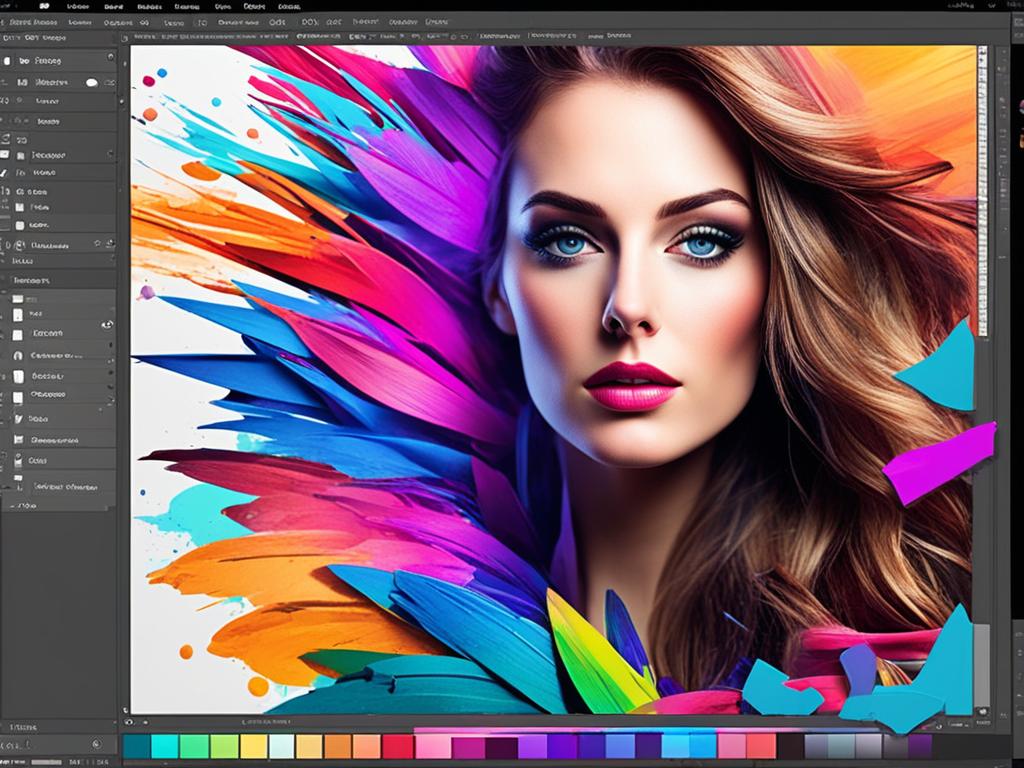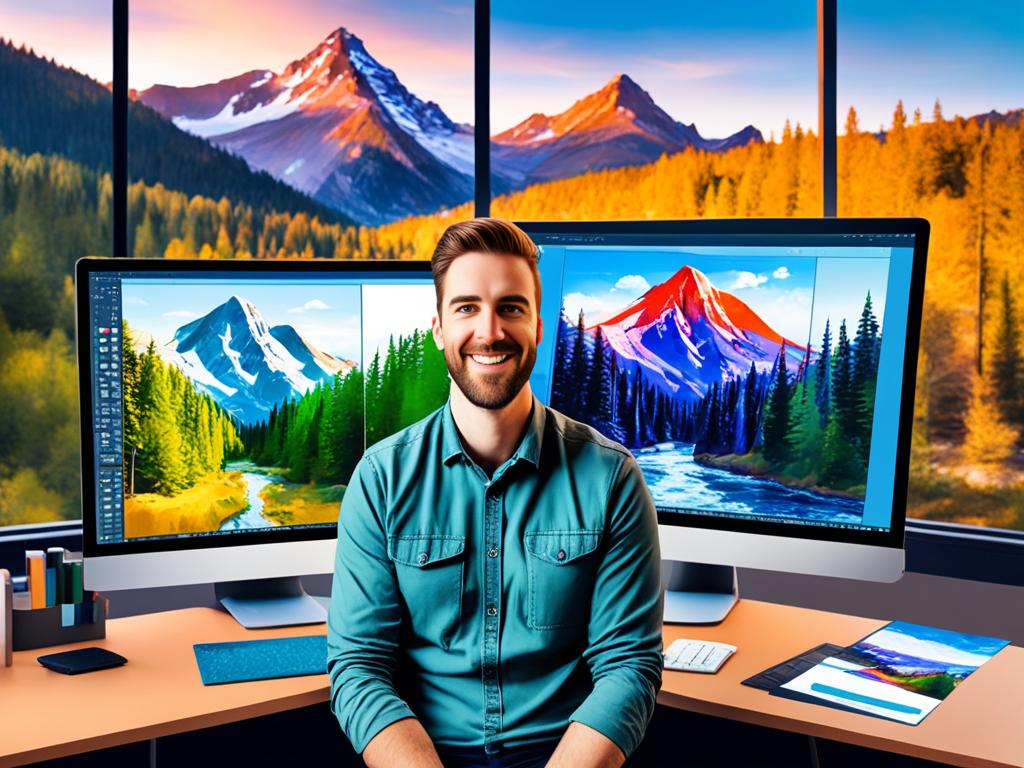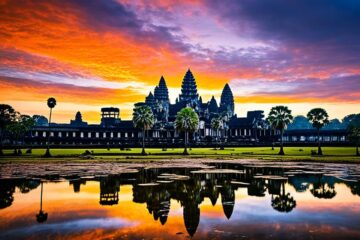Welcome to the complete guide to Adobe Photoshop for digital art! Whether you’re new or experienced, this guide will help your creative journey. Adobe Photoshop is top-notch for changing digital images. It has lots of tools to make your art stand out.
Ever wonder how to make the most of Adobe Photoshop for your art? What if there are secret ways to improve your work? Can you make amazing effects, beautiful designs, or fix photos easily?
This guide will dive into Adobe Photoshop, sharing key tips and tricks. We will cover everything from editing and manipulating photos to creating designs. You will learn how to use Adobe Photoshop for digital art perfectly.
Are you excited to see what Adobe Photoshop can do for your art? Join us on this journey. Let’s find out the amazing art you can create with this powerful tool.
Key Takeaways:
- Adobe Photoshop is a versatile software widely used in the digital art industry.
- This comprehensive guide will reveal essential tips, tricks, and techniques for mastering Adobe Photoshop for digital art projects.
- From image editing and photo manipulation to graphic design and non-destructive editing, Adobe Photoshop offers a wide array of tools and features.
- By exploring the capabilities of Adobe Photoshop, you can unlock your creative potential and produce stunning digital art.
- Remember to practice, experiment, and continuously learn as you embark on your digital art journey with Adobe Photoshop.
Exploring Adobe Photoshop for Image Editing
Let’s dive into the world of Adobe Photoshop. This software comes packed with creative image editing tools. It’s a favorite among pros for turning regular photos into amazing art. Whether you’re a photographer, designer, or just love digital art, Adobe Photoshop has something for you.
Adobe Photoshop is great for editing images. It has tools like the Spot Healing Brush and Clone Stamp that help polish up photos. They can help get rid of blemishes or wrinkles, making your photos look perfect.
Adobe Photoshop also lets you play with colors. You can adjust colors, tones, and saturation to get your images just right. This is perfect for making colors pop in landscapes or fixing the tones in a portrait.
It doesn’t stop there. Adobe Photoshop has lots of filters and effects. You can add everything from subtle glows to bold black and white styles. These features can really make your photos stand out.
Now, let’s check out some important tools in Adobe Photoshop:
1. Selection Tools:
Selection tools like the Marquee and Lasso are very helpful. They let you pick specific parts of an image for editing. This makes working on pictures easier and more focused.
2. Layers:
Layers are key in Adobe Photoshop. They let you edit parts of an image without making permanent changes. You can add effects and adjust layers without harming your original picture.
3. Brushes:
The Brush Tool doesn’t just paint. It has many presets to add textures and effects. You can use it to blend colors, create shadows, or enhance your photos in various ways.
4. Adjustment Layers:
Adjustment Layers let you tweak your images in a flexible way. You can adjust colors and tones without changing the original photo. This means you can experiment without risk.
5. Healing and Retouching Tools:
The Healing and Retouching Tools help you fix photos. With tools like the Spot Healing Brush, you can easily remove unwanted parts of a photo. Your edited photo will look smooth and natural.
Adobe Photoshop’s creative tools are waiting for you. They can help you become a better editor, whether you’re into photography, design, or just having fun. With Photoshop, you can turn your creative ideas into reality.
Mastering Photo Manipulation in Adobe Photoshop
Let’s explore photo manipulation with Adobe Photoshop. This lets us transform and improve images. It opens a new world of creativity. Using the tools shared here, you can make amazing visual effects and unique digital art.
Combining Multiple Images
Adobe Photoshop lets you blend photos seamlessly. This means you can mix different elements to create something new. This can tell meaningful stories or stir emotions.
For example, you can merge a beach sunset with a flying eagle. This mingles freedom and peace in a powerful way.
Applying Layer Masking
Layer masking is vital for photo editing in Photoshop. It lets you hide or show parts of an image. This makes your edits look natural and real.
So, placing a person in a fantasy land looks seamless. The use of layer masking makes the person fit perfectly into the scene.
Utilizing Advanced Editing Tools
Know the advanced tools in Photoshop to edit photos well. Tools like Clone Stamp and Content-Aware Fill help refine images. They remove flaws and make the image more realistic.
These tools help achieve a precise and realistic look in your creations. That makes your work stand out.
By learning to combine images, use layer masking, and the right tools, you can do a lot. You could create surreal landscapes, mythical creatures, or pieces that make people think. Photo manipulation allows you to tell stories and show your creativity.
Unleashing Your Creativity with Graphic Design Tools in Adobe Photoshop
Adobe Photoshop isn’t just an image editor. It’s a top software for creating graphics. You can design all kinds of things, like logos and posters, using its many tools. These tools help turn your ideas into visual masterpieces.
Adobe Photoshop lets you dive into the world of graphic design. It opens up a playground for your creativity. We’ll go through some of its main tools and features in detail.
1. Custom Brushes
Custom brushes are a must-have in Adobe Photoshop. They let you add unique textures and effects to designs. This brings a whole new level of creativity, whether you’re drawing or designing something.
2. Typography Tools
Text is a big part of design, and Photoshop has a lot of tools for it. You can tweak almost anything about the text, from its spacing to its style. This way, your words look just as striking as your images.
3. Layer Styles
“Layer styles are a game-changer in graphic design. With just a few clicks, you can add drop shadows, gradients, bevels, and other effects to your design elements, instantly transforming them into eye-catching visuals.”
Layer styles in Photoshop can make designs pop without much effort. They help you easily create effects like shiny buttons or metallic text. It saves time and makes your work look professional in a snap.
4. Smart Objects
Photoshop’s smart objects are all about being flexible. They let you change parts of your design without losing quality. This makes trying out new ideas a lot smoother for designers.
These tools in Photoshop are just the start. There are so many more features waiting to be discovered. With shapes, filters, and color palettes, your designs can truly stand out.
If you want to get better at graphic design, Photoshop is your best friend. It has everything you need to turn imagination into reality. So, start playing with Photoshop and see where your creativity takes you!

| Graphic Design Tool | Description |
|---|---|
| Custom Brushes | Create unique textures, patterns, and effects |
| Typography Tools | Enhance designs with stylized fonts and effects |
| Layer Styles | Add depth and visual interest to design elements |
| Smart Objects | Resize, transform, and edit elements without losing quality |
Mastering Layer Masking for Non-Destructive Editing in Adobe Photoshop
This part will help you get good at layer masking in Adobe Photoshop. Layer masking lets you edit without changing the image forever. You can adjust and enhance parts without losing the original look.
It’s perfect for working on complex pictures or when you need to edit precisely. You can edit only the parts you want. This means you can keep the rest of the picture as it is.
With layer masks, you can hide or show parts of an image layer. It helps mix different layers smoothly when putting images together. Or when you’re adding cool effects to photos.
To get really good at layer masking, you need to know the basics. Here are some important things to remember:
- Create a Layer Mask: First, make a layer mask for the layer you want to edit. Just select the layer and then click “Add Layer Mask.” This is at the bottom of the Layers palette.
- Painting on the Layer Mask: The mask shows what’s visible and what’s not. White shows up, and black hides stuff. You can use a brush to paint on the mask. This lets you control what people see. Different shades of gray change how clear something is.
- Refining the Layer Mask: Sometimes, you need to make more careful edits. You can use tools like the brush or selection tools to make fine adjustments. This helps your edits mix perfectly with the rest of the image.
- Layer Mask Options: Photoshop has more features to make layer masking even better. You can feather the edges, invert the mask, or change how the mask and layer blend. This can give you cool new effects.
Learning layer masking helps artists improve their work. You can edit without making a change that you can’t undo. This means you’re free to try new things without the worry of messing up the original.
Now, let’s see how layer masking works in a real Adobe Photoshop project:
“Picture a photo of a landscape with a bright sky and dark ground. With layer masking, you can make the sky brighter without changing the ground or other parts. By painting on the mask, you let the updated sky show through. Meanwhile, the dark ground stays unchanged. This method gives you amazing editing control and flawless image blending.”
Layer masking lets photographers balance the light in their photos perfectly. This makes the whole image look great.
| Benefits of Layer Masking in Adobe Photoshop | Examples |
|---|---|
| 1. Non-destructive editing | – Selectively adjusting the color balance of a specific area in a portrait – Enhancing the saturation of only the flowers in a landscape photograph |
| 2. Precise control over edits | – Blending multiple exposures seamlessly – Removing unwanted objects while preserving the surrounding details |
| 3. Seamless composition and compositing | – Combining elements from multiple images to create a cohesive final composition – Adding special effects to photographs without altering the original image |
The table above highlights why layer masking is great in Adobe Photoshop, with examples of what you can do. It’s a major skill for anyone who wants to do professional editing work.
Mastering layer masking is key for digital artists and photographers. It boosts your skills and makes your work shine. Understanding how to use layer masks in Adobe Photoshop brings out your creativity and uses the software to the max.
Perfecting Photo Retouching Techniques in Adobe Photoshop
Section 6 is about advanced photo retouching with Adobe Photoshop. It’s for anyone who loves photos, like professional photographers or new artists. You’ll learn to remove marks, make skin tones better, and create amazing portraits through detailed steps.
Removing Blemishes and Imperfections
First up, say goodbye to blemishes and imperfections in photos. Adobe Photoshop has many tools for this. The spot healing brush and clone stamp help delete marks and pimples. With careful blending, your pictures will look perfect and real.
Enhancing Skin Tones and Textures
Now, let’s make skin look even better with Adobe Photoshop. Tools like the healing brush smooth out skin and reduce redness. The dodge and burn tools add contrast, highlighting skin texture. Using these with care makes your photos look polished and professional.
Creating Eye-catching Portraits
Ready to make your photos stand out more? Adobe Photoshop offers tools to enhance faces. The liquify tool can subtly adjust facial shapes. Brightening eyes makes them more engaging. With these tricks, your photos will captivate.
“Adobe Photoshop provides a wide range of tools and techniques for photo retouching and image editing. With practice and attention to detail, you can transform ordinary photos into extraordinary works of art.” – Sarah Thompson, professional photographer
Getting good at retouching photos takes time. Try new things and find your style. Photoshop has lots of tools for creativity. Keep learning and focusing on details. That’s the key.
| Photo Retouching Techniques | Features |
|---|---|
| Spot Healing Brush Tool | Removes blemishes and imperfections with a single brush stroke. |
| Clone Stamp Tool | Clones pixels from one area to another, allowing you to eliminate unwanted elements. |
| Healing Brush Tool | Fixes skin imperfections by blending textures and tones. |
| Dodge and Burn Tools | Lightens and darkens areas selectively to enhance highlights and shadows. |
| Liquify Tool | Reshapes facial features for subtle adjustments. |
Conclusion
This guide took a detailed look at Adobe Photoshop for digital art projects. We covered many aspects, from editing images and designing graphics to non-destructive changes. Readers now have new skills and insights to improve their art.
Yet, using Adobe Photoshop well is more than just knowing how. It’s about practicing to get better and be more creative. Trying out different tools, methods, and effects helps artists unleash their creativity and make outstanding digital art.
Technology and software always move forward. Keeping up with new things is important. Adobe Photoshop keeps getting better and offers many ways to show your art. By staying curious and open to new ideas, artists can keep growing in digital art.




